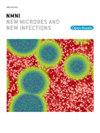多药耐药鲍曼不动杆菌临床分离株粘菌素耐药性调查
IF 5.4
Q2 INFECTIOUS DISEASES
引用次数: 0
摘要
粘菌素被认为是对抗鲍曼不动杆菌晚期耐药菌株的最后手段。各种机制,如影响细菌外膜和外排泵的机制,介导粘菌素耐药性。方法收集100株鲍曼不动杆菌临床分离株,采用标准检验方法进行鉴定。采用微量肉汤稀释法测定9种抗生素及粘菌素对分离菌的最低抑菌浓度(mic)。采用群体分析谱(PAP)测定粘菌素异源耐药性,并进行时间杀伤试验。利用聚合酶链反应(PCR)和测序技术,研究了mcr1-3基因的存在,以及pmrCAB和lpx基因的突变。结果所有分离株均为多重耐药菌株,85%以上的分离株对除粘菌素(MIC≤1 mg/L)外的所有抗生素均耐药。发现11株粘菌素异源耐药菌株。所有异耐药菌株也对亚胺培南耐药。时间杀伤试验表明,在1倍MIC和2倍MIC浓度下,3株异抗菌株分别在6和12 h时表现出明显的再生。所有分离株mcr基因均为阴性。在11株异抗菌株中,有4株出现pmrB、lpxC和lpxD基因突变,1株出现pmrB和lpxD基因双突变。结论本研究提示单药治疗可能产生耐药亚群。这些发现强调了持续监测、使用联合治疗和开发新策略以对抗鲍曼不动杆菌感染的重要性。本文章由计算机程序翻译,如有差异,请以英文原文为准。
Investigation of colistin heteroresistance in multidrug-resistant Acinetobacter baumannii clinical isolates
Background
Colistin is considered a last-resort antibiotic against Acinetobacter baumannii strains with advanced drug resistance. Various mechanisms, such as those affecting the bacterial outer membrane and efflux pumps, mediate colistin resistance.
Methods
One hundred clinical A. baumannii isolates were collected from various infections and identified using standard tests. The minimum inhibitory concentrations (MICs) of nine antibiotics, as well as colistin, against the isolates were determined using the broth microdilution method. The population analysis profile (PAP) was conducted to determine colistin heteroresistance, and a time-kill assay was also performed. Using polymerase chain reaction (PCR) and sequencing, the presence of mcr1-3 genes, as well as mutations in the pmrCAB and lpx genes, were investigated.
Results
All isolates were multidrug-resistant, and more than 85 % of the isolates were resistant to all antibiotics tested except colistin (colistin MIC ≤1 mg/L). Eleven colistin-heteroresistant isolates were found. All heteroresistant isolates were also resistant to imipenem. The time-kill assay indicated at 1 × MIC and 2 × MIC concentrations, the three heteroresistant isolates showed noteworthy regrowth at 6 and 12 h, respectively. All of the isolates were negative for mcr genes. Among 11 heteroresistant isolates, mutations in the pmrB, lpxC, and lpxD genes were found in four isolates, with one isolate having double mutations in the pmrB and lpxD genes.
Conclusion
Our research indicates that resistant subpopulations may develop during colistin monotherapy. These findings highlight the importance of continuous surveillance, the use of combination therapy, and the development of new strategies to combat A. baumannii infections.
求助全文
通过发布文献求助,成功后即可免费获取论文全文。
去求助
来源期刊

New Microbes and New Infections
Medicine-Infectious Diseases
CiteScore
10.00
自引率
2.50%
发文量
91
审稿时长
114 days
 求助内容:
求助内容: 应助结果提醒方式:
应助结果提醒方式:


